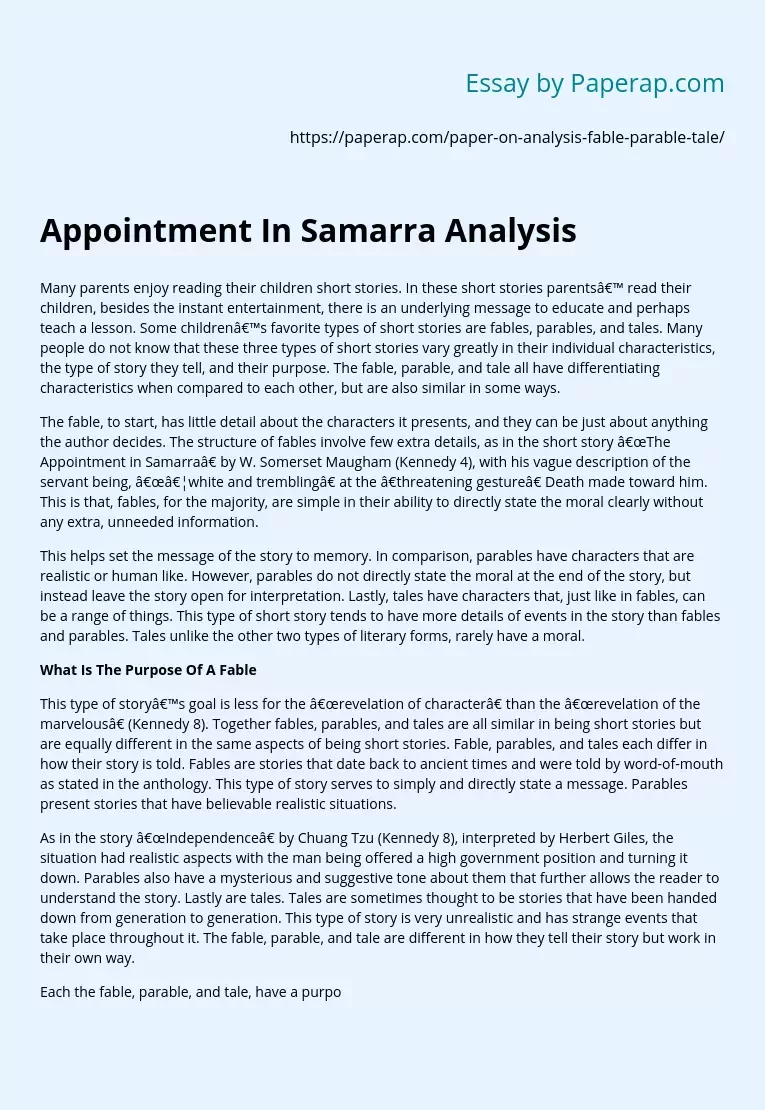Appointment In Samarra Analysis
Many parents enjoy reading their children short stories. In these short stories parents’ read their children, besides the instant entertainment, there is an underlying message to educate and perhaps teach a lesson. Some children’s favorite types of short stories are fables, parables, and tales. Many people do not know that these three types of short stories vary greatly in their individual characteristics, the type of story they tell, and their purpose. The fable, parable, and tale all have differentiating characteristics when compared to each other, but are also similar in some ways.
The fable, to start, has little detail about the characters it presents, and they can be just about anything the author decides. The structure of fables involve few extra details, as in the short story “The Appointment in Samarra” by W. Somerset Maugham (Kennedy 4), with his vague description of the servant being, “…white and trembling” at the ”threatening gesture” Death made toward him. This is that, fables, for the majority, are simple in their ability to directly state the moral clearly without any extra, unneeded information.
This helps set the message of the story to memory. In comparison, parables have characters that are realistic or human like. However, parables do not directly state the moral at the end of the story, but instead leave the story open for interpretation. Lastly, tales have characters that, just like in fables, can be a range of things. This type of short story tends to have more details of events in the story than fables and parables.
Tales unlike the other two types of literary forms, rarely have a moral.
What Is The Purpose Of A Fable
This type of story’s goal is less for the “revelation of character” than the “revelation of the marvelous” (Kennedy 8). Together fables, parables, and tales are all similar in being short stories but are equally different in the same aspects of being short stories. Fable, parables, and tales each differ in how their story is told. Fables are stories that date back to ancient times and were told by word-of-mouth as stated in the anthology. This type of story serves to simply and directly state a message. Parables present stories that have believable realistic situations.
As in the story “Independence” by Chuang Tzu (Kennedy 8), interpreted by Herbert Giles, the situation had realistic aspects with the man being offered a high government position and turning it down. Parables also have a mysterious and suggestive tone about them that further allows the reader to understand the story. Lastly are tales. Tales are sometimes thought to be stories that have been handed down from generation to generation. This type of story is very unrealistic and has strange events that take place throughout it. The fable, parable, and tale are different in how they tell their story but work in their own way.
Each the fable, parable, and tale, have a purpose for their stories. First, the fable serves to teach lessons about life. The fable clearly states a message that can be generalized and applied to life. It presents a statement of truth about the message of the short story. There are two good examples. One in W. Somerset Maugham’s “The Appointment in Samarra” (Kennedy 4) with the moral that you cannot escape death, and the other example in Vernon Jones’ “The North Wind and the Sun” (Kennedy 5), that persuasion is better than force.
The parable serves a similar purpose of teaching a moral just as the fable does, but it instead, uses realistic situations and does not state the moral clearly, thus is open to several interpretations. The parable however can either be literally or with a deeper comprehension of the story, understood. The tale is a story that is mainly used to entertain the reader. Tales range from being fairy tales, tall tales, and folk tales and can be highly exaggerated, mysterious, and surround around the setting of the story.
Each of these short stories purpose is of a great use and importance in the development of many people from being young children to adults with the lessons they’ve learned and interpreted, and the stories they can pass down from one generation of children, to another. Together fables, parables, and tales are equally different and similar in their individual characteristics, how they tell their story, and the purpose they serve in the development of young children to adults with lessons and memorable stories to share. The appreciation one can gain from each type of literary forms has lasted throughout many centuries and is continuing on.
Appointment In Samarra Analysis. (2019, Dec 05). Retrieved from https://paperap.com/paper-on-analysis-fable-parable-tale/

